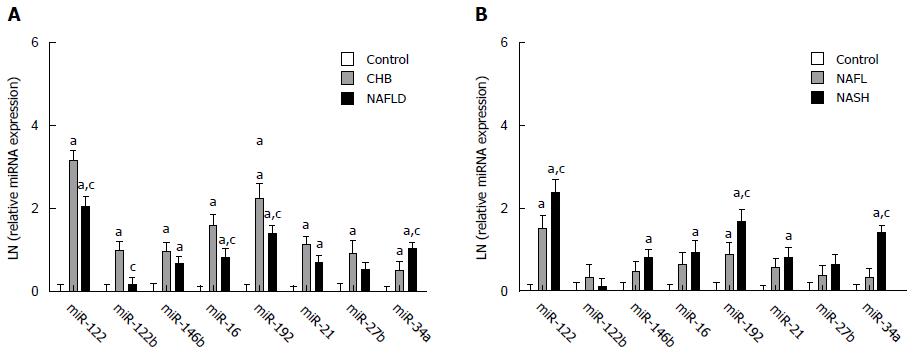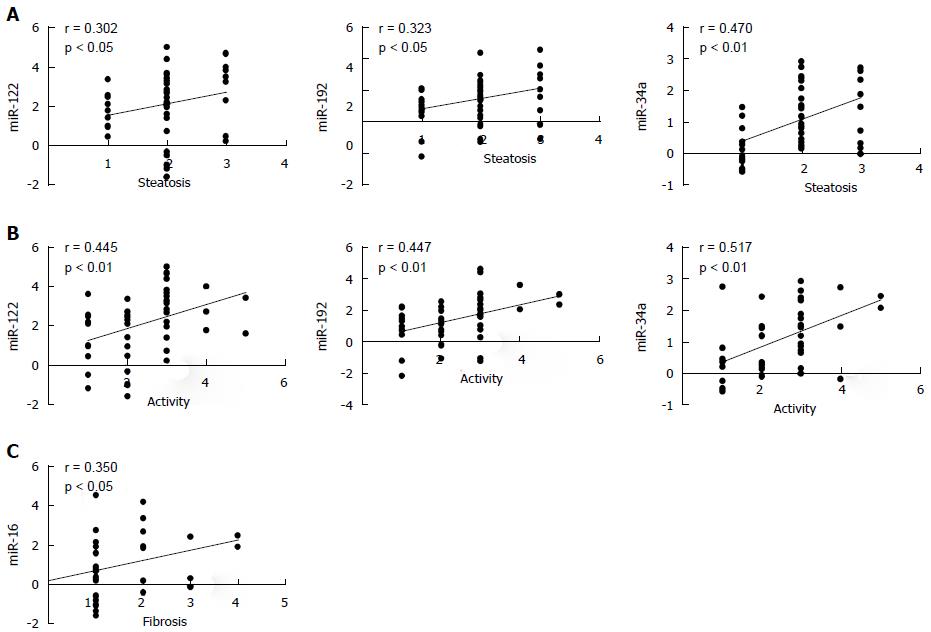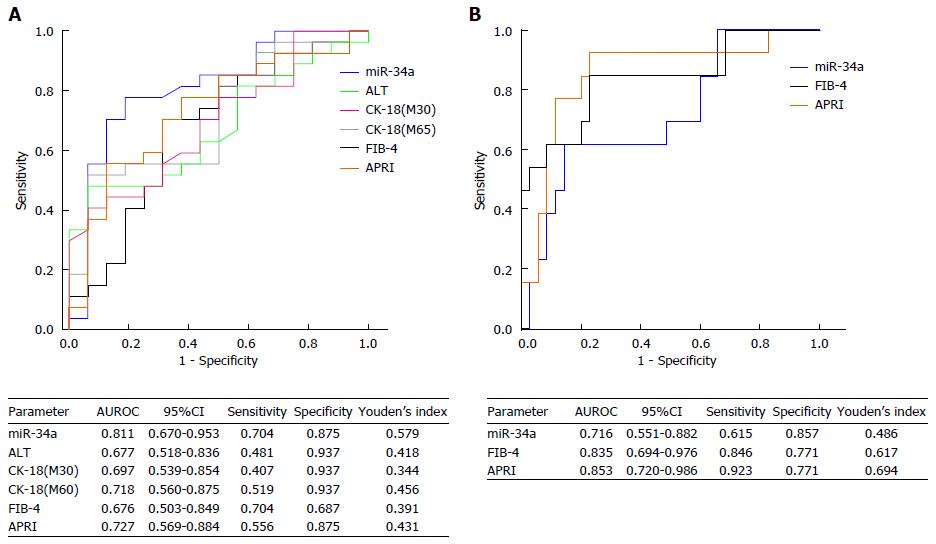Copyright
©The Author(s) 2016.
World J Gastroenterol. Nov 28, 2016; 22(44): 9844-9852
Published online Nov 28, 2016. doi: 10.3748/wjg.v22.i44.9844
Published online Nov 28, 2016. doi: 10.3748/wjg.v22.i44.9844
Figure 1 Serum cytokeratin-18 (M30) and cytokeratin-18 (M65) levels in chronic hepatitis B (A) and non-alcoholic fatty liver disease patients, as well as non-alcoholic fatty liver and non-alcoholic steatohepatitis (B) patients.
CK-18 (M30) and CK-18 (M65) showed a higher level in non-alcoholic steatohepatitis (NASH) patients than non-alcoholic fatty liver (NAFL) patients (P < 0.001), but they showed no significant difference between the non-alcoholic fatty liver disease (NAFLD) patients and chronic hepatitis B (CHB) patients. aP < 0.05 vs the control group; A: cP < 0.05 vs the CHB group; B: cP < 0.05 vs the NAFL group. CK-18: Cytokeratin-18.
Figure 2 Serum miRNA expression profile among control (A), chronic hepatitis B and non-alcoholic fatty liver disease patients, as well as control (B), non-alcoholic fatty liver and non-alcoholic steatohepatitis patients.
All eight miRNAs, except miR-125 and -27b, were up-regulated in the non-alcoholic fatty liver disease (NAFLD) group compared with the control group (P < 0.05), with miR-34a being even higher and miR-122, -16 and -192 being lower in the NAFLD group compared with chronic hepatitis B (CHB) group (P < 0.01; Figure 2A). Among the miRNAs, miR-122, -192 and -34a showed significant differences not only between the NAFLD and the control groups but also between the non-alcoholic steatohepatitis (NASH) and the non-alcoholic fatty liver (NAFL) groups (P < 0.001; Figure 2B). aP < 0.05 vs the control group; A: cP < 0.05 vs the CHB group; B: cP < 0.05 vs the NAFL group.
Figure 3 Correlation between circulating miRNAs and hepatic steatosis (A), activity (B) and fibrosis (C) in non-alcoholic fatty liver disease patients.
Circulating miR-122, -192 and -34a were correlated with hepatic steatosis (P < 0.05) and inflammatory activity (P < 0.01). However, only miR-16 was associated with hepatic fibrosis (P < 0.05). Activity is the sum of the score of lobular inflammation and hepatocellular ballooning.
Figure 4 Receiver operating characteristic curve of miR-34a, alanine aminotransferase, cytokeratin-18, fibrosis-4 and aspartate aminotransferase to platelet ratio index for on-alcoholic steatohepatitis (A) and miR-16, fibrosis-4 and aspartate aminotransferase to platelet ratio index for significant fibrosis (B) diagnosis in non-alcoholic fatty liver disease.
The AUROC of miR-34a and miR-16 for non-alcoholic steatohepatitis (NASH) and significant fibrosis were 0.811 and 0.716, respectively. Circulating miR-34a significantly increased the sensitivity to 0.704, with a comparable specificity. For the diagnosis of significant fibrosis, miR-16 displayed a relatively lower AUROC than that of FIB-4 and APRI. ALT: Alanine aminotransferase; CK-18: Cytokeratin-18; FIB-4: Fibrosis-4; APRI: Aspartate aminotransferase to platelet ratio index.
- Citation: Liu XL, Pan Q, Zhang RN, Shen F, Yan SY, Sun C, Xu ZJ, Chen YW, Fan JG. Disease-specific miR-34a as diagnostic marker of non-alcoholic steatohepatitis in a Chinese population. World J Gastroenterol 2016; 22(44): 9844-9852
- URL: https://www.wjgnet.com/1007-9327/full/v22/i44/9844.htm
- DOI: https://dx.doi.org/10.3748/wjg.v22.i44.9844












